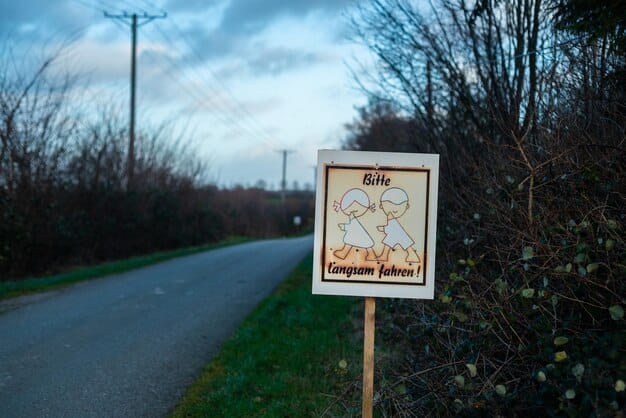Reporting Suspicious Activity: A Guide to Neighborhood Safety

Reporting suspicious activity in your neighborhood is crucial for effective crime prevention, involving recognizing unusual behavior, knowing how to document it, and understanding the proper channels for reporting to local authorities, ensuring a safer community for everyone.
Is there something happening in your neighborhood that just doesn’t feel right? Learning how to report suspicious activity in your neighborhood can be a vital step towards effective crime prevention, fostering a safer environment for you and your community members.
Understanding Suspicious Activity
Before you can effectively report suspicious activity, it’s essential to understand what constitutes it. Identifying unusual or out-of-place behavior can be the first step in preventing crime and ensuring community safety. Recognizing these signs allows for timely reporting, potentially averting more serious incidents.
Defining Suspicious Behavior
Suspicious behavior isn’t always obvious, but it often deviates from the norm. It may involve actions or circumstances that seem unusual or out of context. Recognizing these signs is crucial. But what exactly falls under the umbrella of “suspicious”?
- Long periods of vehicle idling in front of businesses or homes.
- Individuals repeatedly loitering in the same area for no apparent reason.
- Unusual or excessive interest in a property, such as prolonged observation.
- Carrying items that don’t match the time of day or location.
Understanding these behaviors helps residents stay vigilant. By knowing what to look for, community members become active participants in maintaining safety.
Context Matters
It’s also important to consider the context of the situation. What might be suspicious in one neighborhood could be perfectly normal in another. For example, seeing someone walking around late at night might be unusual in a quiet residential area but common in a lively downtown district.

Assessing the entire scenario is key. Consider the time of day, the location, and the individuals involved. This holistic approach ensures that reports are based on genuine concerns rather than assumptions.
In summary, understanding suspicious activity involves recognizing unusual behaviors and considering the context in which they occur. Stay alert and trust your instincts, but always aim to report based on observation and thoughtful consideration.
Documenting Suspicious Activity
When you observe something suspicious, accurately documenting it can be crucial. Detailed documentation provides law enforcement with the information they need to investigate effectively. Gathering as much information as possible without putting yourself at risk is essential.
What Information to Gather
Recording specific details can significantly enhance the effectiveness of your report. Focus on factual observations rather than personal interpretations. Precise and accurate documentation is key.
- Date and Time: Record the exact date and time you observed the activity.
- Location: Note the specific location, including street names and addresses.
- Description of People: Provide details such as gender, race, age, height, weight, clothing, and any distinguishing marks.
- Description of Vehicles: Include the make, model, color, license plate number, and any unique features.
Capture as many details as possible. This level of specificity can be invaluable in identifying patterns and linking activities to potential crimes.
Tools for Documentation
Using simple tools can help streamline the documentation process. Whether you prefer traditional methods or digital tools, find what works best for you. These tools can make it easier to record details quickly and accurately.
Consider keeping a small notebook and pen handy. Alternatively, use the voice recorder on your smartphone to dictate observations. Many people find that using a smart device to log notes in real-time is effective.
Remember, it is ideal to document everything as soon as possible after the event. This ensures accuracy and reduces the chance of forgetting important details.
Documenting suspicious activity accurately enhances the quality of your report. By focusing on factual details and using effective tools, you contribute significantly to law enforcement efforts.
Reporting Suspicious Activity: Who to Contact
Knowing who to contact when reporting suspicious activity is essential for ensuring a timely and effective response. Reporting channels vary depending on the nature of the activity and your location. Understanding these options helps direct your report to the appropriate authorities.
Local Law Enforcement
For immediate threats or crimes in progress, contact your local law enforcement agency directly. They are equipped to respond swiftly and address urgent situations. Calling the police can be the quickest way to get help when it’s needed most.
Use 911 for emergencies requiring immediate attention. For non-emergency situations, find the local police department’s non-emergency number. Keep these numbers readily accessible in your phone or on a bulletin board.
Neighborhood Watch Programs
If your community has a neighborhood watch program, they can serve as a valuable resource. These programs often have direct lines of communication with law enforcement. Engaging with neighborhood watch can enhance your community’s overall security.

Participate in meetings to stay informed about local crime trends. Share your observations and concerns with other members. Work together to create a safer environment.
Online Reporting Systems
Many law enforcement agencies now offer online reporting systems for non-emergency situations. These platforms allow you to submit reports from the convenience of your home. Online systems provide a convenient alternative for reporting less urgent matters. However, they are not appropriate for emergencies.
Visit your local police department’s website to check if they offer an online reporting tool. Follow the prompts and provide as much detail as possible. Save a copy of your submission for your records.
Knowing who to contact ensures your report reaches the right people quickly. Local law enforcement, neighborhood watch programs, and online systems each play a role in community safety.
Effective Communication with Law Enforcement
Communicating effectively with law enforcement is crucial for ensuring your report is taken seriously and acted upon. Clear and concise communication helps officers understand the situation and respond appropriately. Knowing how to articulate your concerns can make a significant difference.
Providing Clear and Concise Information
When speaking with law enforcement, provide information in a clear and structured manner. Avoid ambiguity and focus on the facts. Organize your thoughts to present a coherent account.
Start by stating the exact location, date, and time of the incident. Clearly describe what you observed and who was involved. Use simple language and avoid jargon.
Avoiding Assumptions and Biases
Sticking to factual observations is essential. Avoid making assumptions or letting personal biases influence your report. Presenting objective information helps law enforcement make accurate assessments.
Leave the interpretation of events to the professionals. Focus on describing what you saw, heard, or experienced. Avoid drawing conclusions based on limited information.
Staying Calm and Respectful
Maintaining a calm and respectful demeanor can significantly improve the interaction. Law enforcement officers are more likely to respond positively to those who remain composed. Even when stressed, strive to be respectful.
Speak clearly and avoid raising your voice. Answer their questions honestly and to the best of your ability. Your cooperation can expedite the process.
Effective communication with law enforcement involves providing clear information, avoiding biases, and staying calm. These practices help ensure your report is taken seriously and acted upon appropriately.
Community Collaboration for Crime Prevention
Community collaboration is a powerful tool for preventing crime and fostering a safer neighborhood. When residents work together, they create a network of vigilance and support that deters criminal activity. Building strong relationships within the community can significantly enhance safety.
Joining or Starting a Neighborhood Watch
Participating in a neighborhood watch program is an excellent way to get involved in crime prevention. If one doesn’t exist in your area, consider starting one. Neighborhood watch initiatives mobilize residents to work together. It enhances communication and cooperation.
Organize regular meetings to discuss safety concerns and share information. Establish a communication system for reporting suspicious activity promptly. Coordinate with local law enforcement for guidance and support.
Organizing Community Events
Organizing community events helps build relationships among neighbors. Social connections strengthen the sense of community. This makes the neighborhood safer.
- Block Parties: These gatherings allow neighbors to meet and interact.
- Clean-Up Days: Working together to beautify the neighborhood fosters community pride.
- Safety Workshops: Educate residents on crime prevention techniques.
Positive social interactions strengthen community bonds. Neighbors who know each other are more likely to look out for one another.
Utilizing Social Media and Online Forums
Social media and online forums can facilitate communication and information sharing within the neighborhood. These platforms can be used to disseminate important updates.* Sharing information ensures everyone stays informed.
Create a private group for residents to share safety tips and report suspicious activity. Use the platform to announce community events and important meetings. Always verify information before sharing it to prevent the spread of misinformation.
Community collaboration is vital for crime prevention. Joining a neighborhood watch, organizing community events, and utilizing social media can create a safer, more connected neighborhood.
The Importance of Anonymity
Some individuals may hesitate to report suspicious activity due to concerns about their safety or privacy. Fortunately, in many cases, you can report anonymously. Understanding the options for anonymous reporting can encourage more people to come forward and share vital information.
When to Request Anonymity
If you feel uncomfortable providing your name, you have the right to request anonymity when reporting. This option allows you to share information without revealing your identity. Requesting anonymity can protect you from potential retaliation.
When contacting law enforcement, clearly state that you wish to remain anonymous. Ask about the process for submitting an anonymous report. Be aware that anonymous reports may have certain limitations regarding follow-up investigations.
Maintaining Confidentiality
Even if you provide your name, your information is generally kept confidential. Law enforcement agencies typically protect the identity of reporters to prevent harassment or intimidation. Confidentiality ensures reporters feel safe and secure.
- Do not discuss your report with unauthorized individuals.
- Avoid posting details about the incident on social media.
- Trust that law enforcement will keep your identity secure.
Benefits of Anonymous Reporting
Anonymous reporting can significantly increase the number of tips received by law enforcement. It encourages individuals who might otherwise remain silent to come forward. Higher tip numbers can enable investigations to be carried out successfully.
Anonymous reporting empowers individuals to contribute to community safety without fear. It fosters a culture of vigilance and encourages active participation. With more information available, law enforcement can more effectively address criminal activity and protect the community.
Understanding the options for anonymity is essential for encouraging community participation in crime prevention. Anonymous reporting empowers individuals to share information without fear, contributing to a safer neighborhood.
| Key Point | Brief Description |
|---|---|
| 👀 Identifying Suspicious Activity | Recognize unusual behaviors, such as loitering or prolonged observation of properties. |
| 📝 Documenting Details | Record date, time, location, descriptions of people and vehicles involved. |
| 📞 Reporting to Authorities | Contact local law enforcement via 911 for emergencies or the non-emergency line. |
| 🛡️ Community Involvement | Join neighborhood watch programs and collaborate with neighbors for crime prevention. |
FAQ
▼
Suspicious activity includes any behavior that deviates from the norm, such as loitering, unusual vehicle activity, or prolonged observation of homes and businesses.
▼
Record the date, time, and specific location of the activity. Describe any individuals or vehicles involved, including details like clothing, appearance, or license plate numbers.
▼
For emergencies, call 911. For non-emergencies, contact your local police department’s non-emergency number or use their online reporting system, if available.
▼
Yes, you can often report suspicious activity anonymously. When contacting law enforcement, clearly state that you wish to remain anonymous to protect your privacy.
▼
Community collaboration, such as participation in neighborhood watch programs, fosters a safer environment by increasing vigilance and building stronger relationships among neighbors.
Conclusion
Reporting suspicious activity is a critical component of effective crime prevention. By understanding what constitutes suspicious behavior, knowing how to document it, and utilizing the appropriate reporting channels, you can play an active role in maintaining the safety and security of your neighborhood. Remember, your vigilance and willingness to report can make a significant difference in creating a safer community for everyone.





